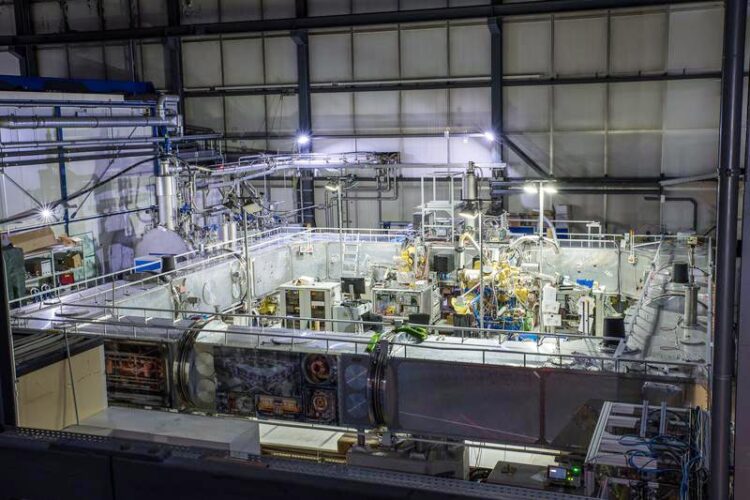Collisions with electrons cool molecular ions

The cryogenic storage ring CSR at the Max Planck Institute for Nuclear Physics with the electron cooler.
MPIK, Ralf Lackner
Laser spectroscopic measurements on methylidene ions in the CSR using the elektron cooler.
A lone molecule free in cold space will cool by slowing down its rotation − it will spontaneously lose its rotational energy in quantum transitions, typically only once in many seconds. This process can be accelerated, slowed down, or even inverted by collisions with surrounding particles.
In an experiment at the ultracold storage ring CSR, researchers of the MPI for Nuclear Physics measured the rate of quantum transitions due to encounters between molecules and electrons by bringing isolated, charged molecules in contact with electrons under controlled conditions at about 26 kelvins.
Thus, they could make this rate – only known by complex calculations so far – high enough to be quantitatively determined in an experiment at last. They probed the occupation of quantum energy levels in methylidene ions (CH+) by laser spectroscopy during up to 10 minutes of storage.
As the spontaneous quantum transitions generate electromagnetic radiation, they are connected to black-body excitation of the molecules, as well. Thus, the electrons compete with the ubiquitous radiative interactions to determine the occupation of rotational quantum levels in cold molecules.
Therefore, electron-induced rates of quantum-level changes are crucial in analyzing, e.g., the faint signals of molecules in space detected by radio telescopes, or in predicting level-dependent chemical reactivity in dilute, cold plasmas.
Wissenschaftliche Ansprechpartner:
Ábel Kálosi
Tel.: +49 6221 516-504
E-Mail: abel.kalosi@mpi-hd.mpg.de
Dr. Oldřich Novotný
Tel.: +49 6221 516-547
E-Mail: oldrich.novotny@mpi-hd.mpg.de
Prof. Dr. Andreas Wolf
Tel.: +49 6221 516-503
E-Mail: andreas.wolf@mpi-hd.mpg.de
Originalpublikation:
Laser-probing the rotational cooling of molecular ions by electron collisions, Ábel Kálosi, Manfred Grieser, Robert von Hahn, Ulrich Hechtfischer, Claude Krantz, Holger Kreckel, Damian Müll, Daniel Paul, Daniel W. Savin, Patrick Wilhelm, Andreas Wolf, and Oldrich Novotný, Phys. Rev. Lett. 128, 183402 (2022), https://doi.org/10.1103/PhysRevLett.128.183402
Weitere Informationen:
https://physics.aps.org/synopsis-for/10.1103/PhysRevLett.128.183402 Physics synopsis: Electron-Ion Collisions Measured in a Cryogenic Facility
Media Contact
All latest news from the category: Physics and Astronomy
This area deals with the fundamental laws and building blocks of nature and how they interact, the properties and the behavior of matter, and research into space and time and their structures.
innovations-report provides in-depth reports and articles on subjects such as astrophysics, laser technologies, nuclear, quantum, particle and solid-state physics, nanotechnologies, planetary research and findings (Mars, Venus) and developments related to the Hubble Telescope.
Newest articles

Innovative 3D printed scaffolds offer new hope for bone healing
Researchers at the Institute for Bioengineering of Catalonia have developed novel 3D printed PLA-CaP scaffolds that promote blood vessel formation, ensuring better healing and regeneration of bone tissue. Bone is…

The surprising role of gut infection in Alzheimer’s disease
ASU- and Banner Alzheimer’s Institute-led study implicates link between a common virus and the disease, which travels from the gut to the brain and may be a target for antiviral…

Molecular gardening: New enzymes discovered for protein modification pruning
How deubiquitinases USP53 and USP54 cleave long polyubiquitin chains and how the former is linked to liver disease in children. Deubiquitinases (DUBs) are enzymes used by cells to trim protein…


